In this article, I’m going to walk you what it is like diving in Mexico. You see, scuba diving is one of my favorite activities to do while I am traveling. It is not only fun and exciting, but jam packed with adrenaline.
In addition to that, every dive is always different and never offers the same experience, even when diving in the same spot. Diving is a great way to see a different side of the country you are visiting. One that most people don’t get to see because they are either uncertified or afraid to go.
Because of Mexico’s vast coastline and massive ocean coverage means there is much more to be discovered than in other countries.
You are able to dive with whale sharks, the world’s second largest coral reef, underwater museums as well as having the unique and rare opportunity to dive freshwater cenotes.
With its vast range of diving options, Mexico truly is a bucket list dive destination for any advanced or beginner diver.
So get ready, pack your bags for Mexico and let’s dive into where to scuba in Mexico.
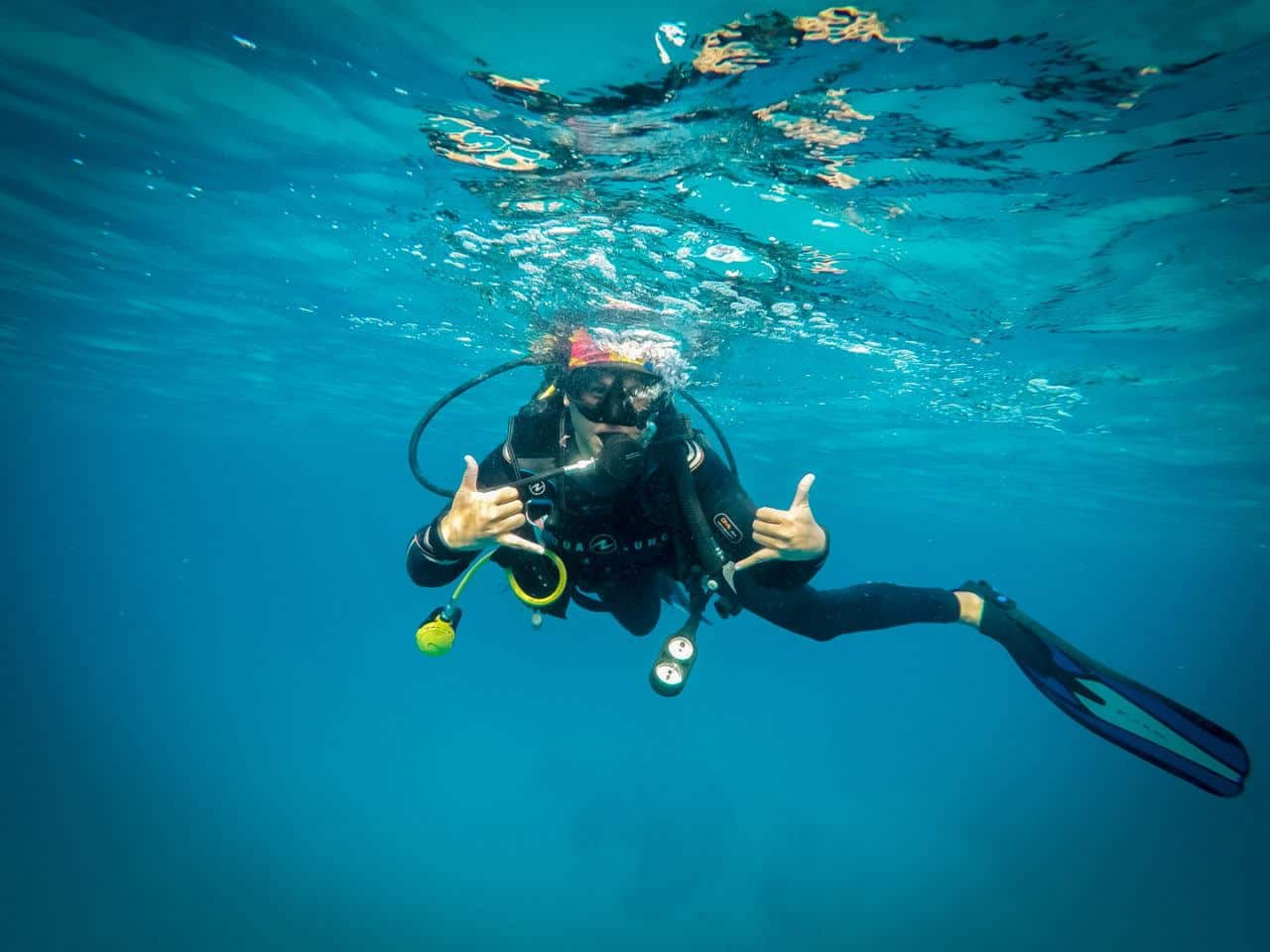
View Contents
- Best Time to Scuba Dive in Mexico
- Best Places to go Scuba Diving in Mexico
- 1. Afuera, Isla Mujeres
- 2. Cancun Underwater Museum
- 3. Palancar Reef, Cozumel
- 4. Cenotes, Yucatan Peninsula
- 5. Bull Shark Diving, Playa Del Carmen
- 6. La Paz, Sea of Cortez
- 7. Socorro Island, Baja Peninsula
- 8. Xcalak, MesoAmerican Reef
- 9. Guadalupe Island, Baja California Peninsula
- 10. Cabo Pulmo, Baja California
- Liveaboard Diving in Mexico
- What you need to know before Diving in Mexico
Best Time to Scuba Dive in Mexico
The best time to go scuba diving in the waters of Mexico can vary depending on the specific location and the type of diving you are interested in. In general, the best time to go explore the underwater life in Mexico is during the dry season, which runs from November to May.
During this time, the waters are usually calm and clear, making for ideal diving conditions. The temperature of the water can also be more comfortable during this time, as it is usually warmer than during the wet season.
It’s worth noting that the busiest times for diving here are typically during the winter months, when many tourists flock to the country to escape the cold weather in their own countries.
If you’re planning to dive along the Pacific, the ideal months to go diving is from November to May.
Whale shark sightings are common during the months of November and December while winter brings about Humpback whales. This is also a great time to do the bull shark dives in Playa del Carmen.
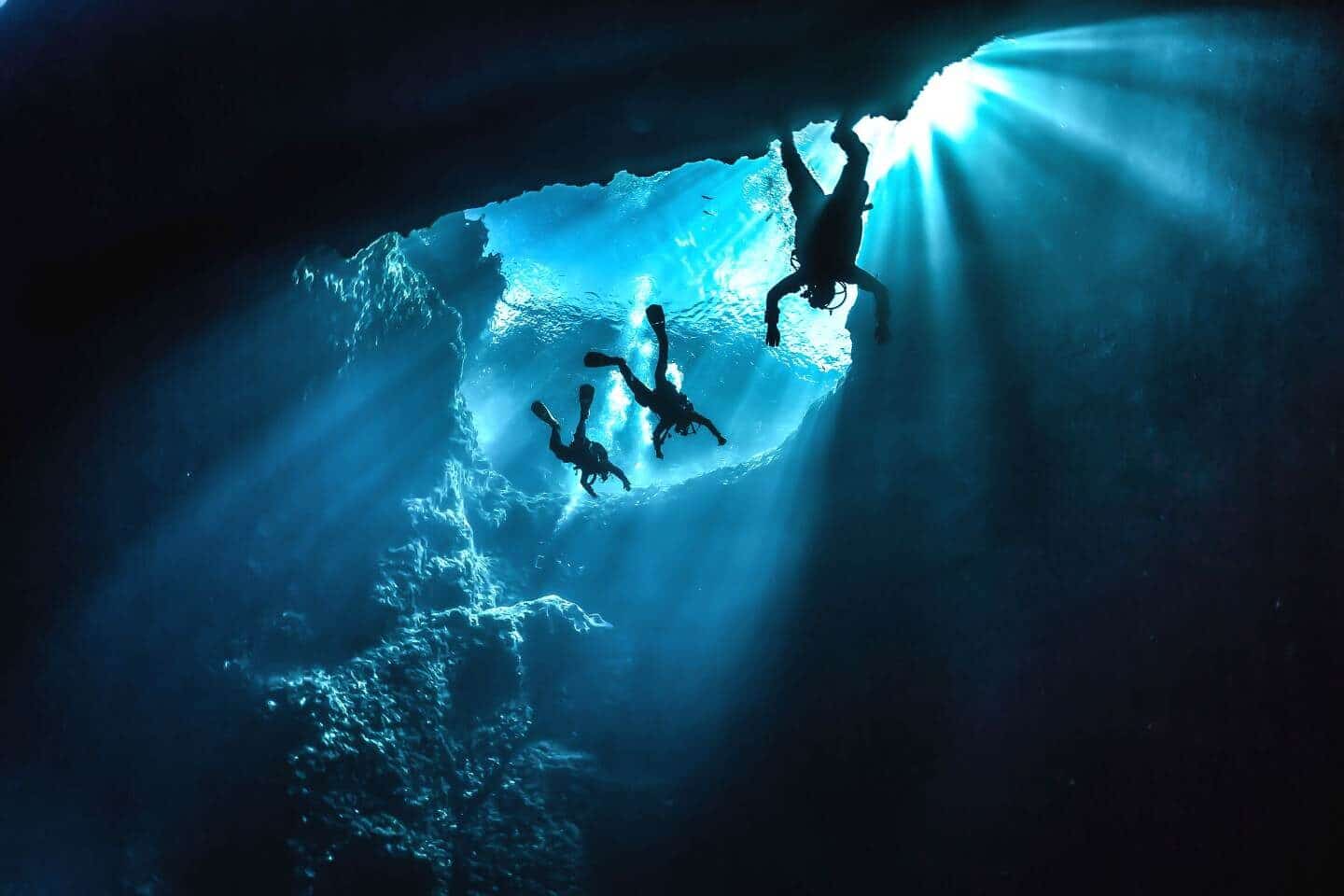
✨The 1 Thing We Never Leave Home Without…✨

Coming from someone who has been traveling the world for the last 8 years AND has been in the hospital 2x, travel insurance is something everyone NEEDS to get. Get a quote below!
Best Places to go Scuba Diving in Mexico
1. Afuera, Isla Mujeres
Have you ever wanted to swim with whale sharks? Then Afuera is where you want to come. Located in the Mexican state of Quintana Roo in the Yucatan Peninsula, Isla Mujeres is an island where the Gulf of Mexico and the Caribbean sea meet.
It is home to some of the best whale shark diving in the world as whale sharks gather here every summer. They are so prevalent, that most dive shops guarantee you will see them.
From early June to late September, whale sharks gather around to feed on the planktons in the Yucatan Peninsula.
This does tend to attract quite a lot of tourists, not creating the most peaceful experience with the whale sharks. However, you will see them.
Isla Mujeres is easy to access by flying into Cancun and taking a ferry. You can also stay in Cancun as some dive shops will operate from there, but I highly recommend skipping the crowds and staying overnight as diving with whale sharks is one of the best things to do in Isla Mujeres as well as our guide on how to get from Cancun to Isla Mujeres.
Plan on coming in the summer months if you are wanting to dive with whale sharks (May-August)
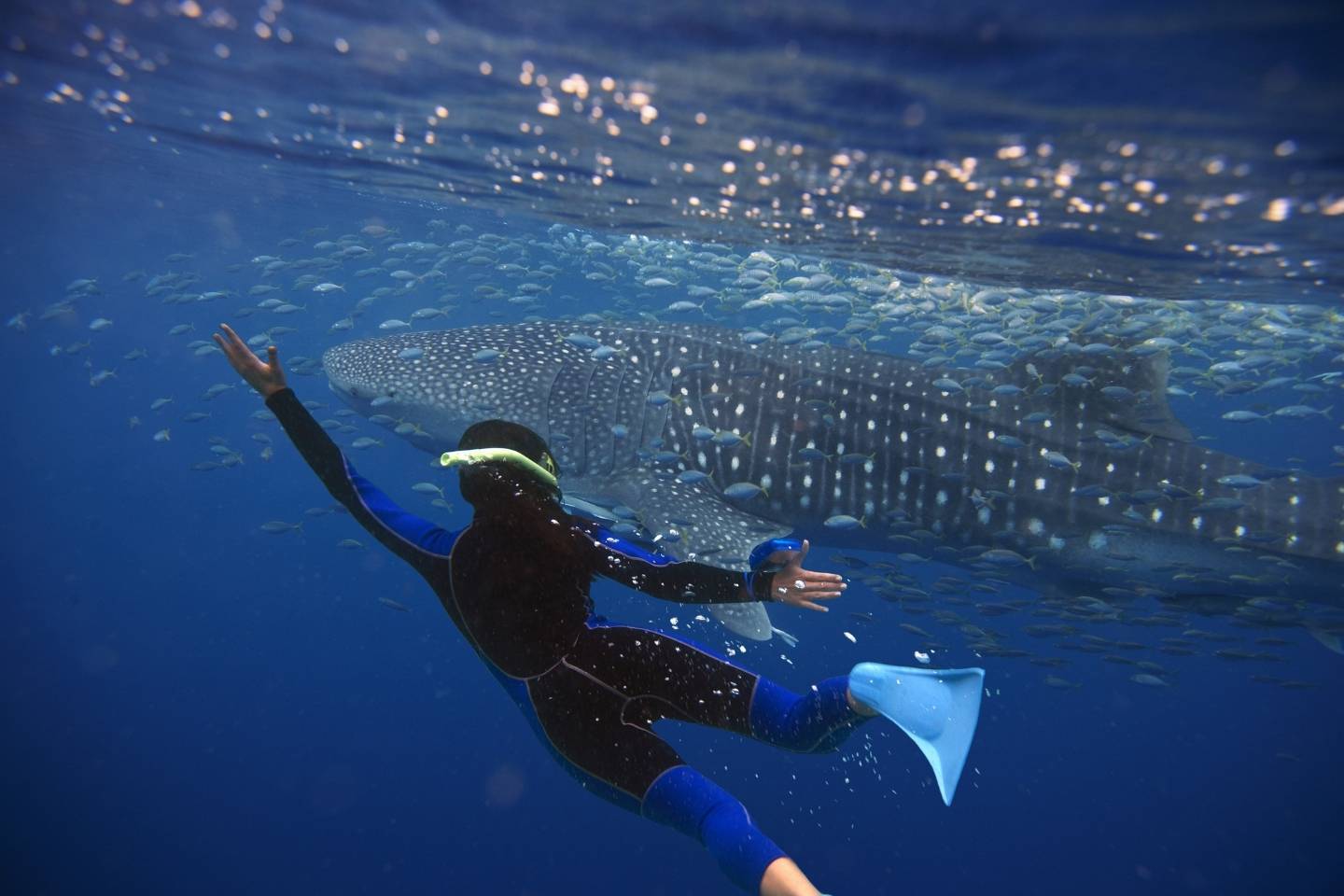
Psst...Want in on a Secret? 🤫

We've scoured the internet for the best ALL-AROUND travel shoe and Tropicfeel wins by far. We've taken ours through rivers, jungles, and cities and they're still alive and kickin'. Check them out below.
2. Cancun Underwater Museum
If normal museums bore you, you might want to check out the underwater museum in Cancun. It is a museum like no other as it is all underwater.
The Cancun underwater museum is home to over 500 sculptors all under water, with most of the artwork coming from the British Sculptor Jason deCaires Taylor.
The idea of an underwater museum came about in efforts to protect the coral reefs. This way divers would have an opportunity to have alternative sites to dive giving the coral reefs a break and allowing them to heal.
It is a great and unique diving opportunity that you won’t find many other places, and a great spot to enjoy year round. Check out this post for a complete guide on the best time to visit Cancun.
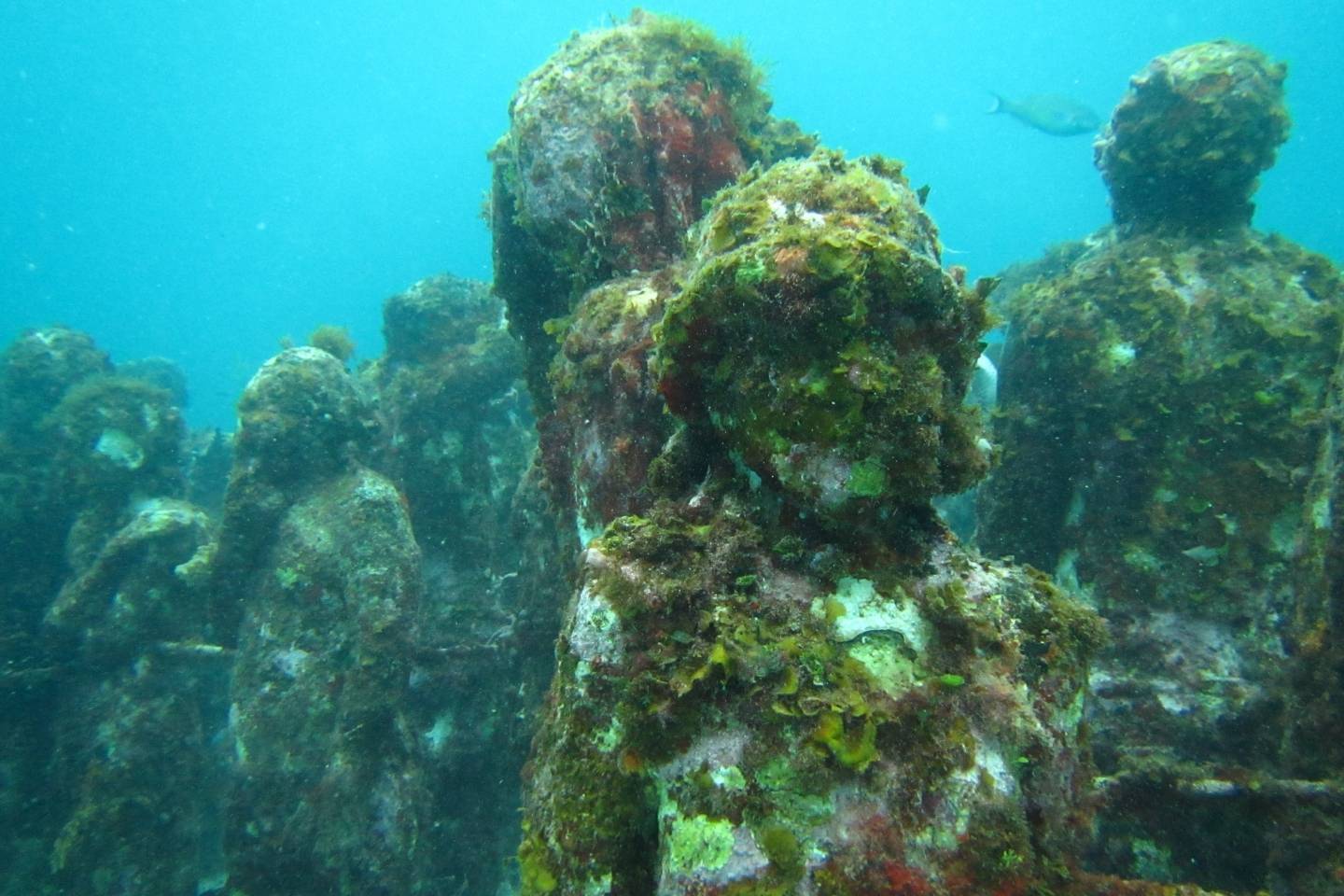
3. Palancar Reef, Cozumel
The Palancar Reef is part of the MesoAmerican Reef, which is the largest reef in the Western Hemisphere. It stretches over 625 miles and over four countries Honduras, Guatemala, Belize, and of course Mexico. Scuba diving here is one of the best in the country!
The Palancar Reef is a special section of the MesoAmerican Reef. It is a national park and a special protected section of the reef. Here you will find over 600 different types of species of fish and 65 different types of coral.
Making it not only a great place to see bright and vibrant coral, but also wildlife. Here you are liking to see sea turtles, eagle rays, nurse sharks, giant manta rays, as well as other sea life. Another great spot that can be enjoyed year round.
The highlight of diving in Cozumel are the coral pinnacles rising from the bottoms! If you’re interested in diving in Cozumel, make sure you check out our full guide!
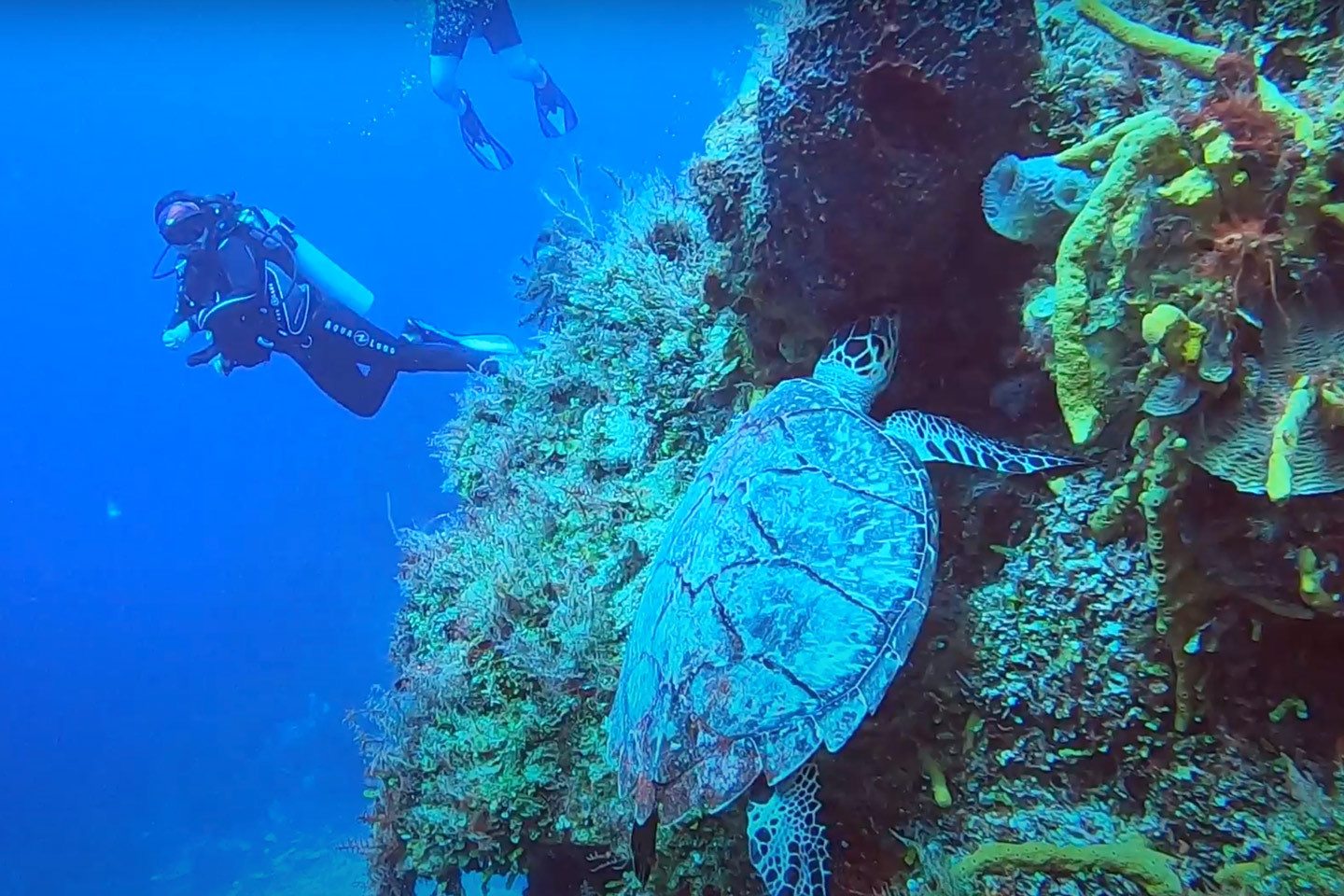
4. Cenotes, Yucatan Peninsula
One thing that makes scubadiving in Mexico unique and special is not only the abundance and variety of ocean diving all around this adventurous country but also the rare cenotes diving that you can partake in.
Cenotes are ancient freshwater sinkholes that are all over the Yucatan Peninsula. They are popular with the tourists for swimming, relaxing, taking Instagram worthy shots, but most importantly diving.
Because cenotes vary per sinkhole on their freshwater to saltwater ratio, their marine life also varies. However, what makes the cenotes unique and different is not their marine life, but actually their geological formations.
Generally speaking, you are cave diving when you explore these cenotes so make sure you are safe and comfortable by researching your scuba diving company ahead of time.
During these cave dives, you will find stalagmites and stalactites and huge pillars deep within the cenotes as you swim through these large underwater caves. You will also be blown away from the clearness in the water since it is mainly freshwater. This makes the visibility amazingly good.
Diving in the cenotes is a unique and bucket list dive experience that every diver needs to add to their list. While the Merida cenotes gain a lot of popularity, the cenotes by Playa del Carmen, Riviera Maya Cenotes and Tulum Cenotes are the ones that are frequented for diving.

5. Bull Shark Diving, Playa Del Carmen
Shark diving is one of my favorite dives I have done. Sharks are amazing and harmless creatures. It is heartbreaking how our society views and treats them.
However, once you dive with them and actually get to see sharks in their true habitat, you can start to better understand them and appreciate them more.
Bull sharks like many other sharks are not aggressive towards humans. So have no fear. Playa del Carmen is a hot spot for Bull shark diving because every year Female Bull sharks return to their shallow waters for breeding. This is mainly due to the fact that they are attracted to the warm waters that they find here.
You won’t be able to find Bull sharks in Playa del Carmen all year round, so if it is a dive that you are wanting to do be sure to visit between November – March when you are more likely to see them.
Heading to Playa del Carmen? Check our our Playa del Carmen Hotel guide to figure out the best areas to stay and make sure you read up on Is Playa Del Carmen Safe?
6. La Paz, Sea of Cortez
Let’s now jump over to the other side of Mexico, in Baja California. It’s not always as popular with the divers, as its waters are better known with the surfers, but that doesn’t make it any less epic.
The water is much colder on the Pacific side, although the Sea of Cortez is the warmest part, mainly because it is more protected. Since the water is cooler, the marine life that you will see will vary from the Caribbean side.
Divers faulk here for the pelagic sea life, which is different from the bright colorful fish and freshwater cenotes we have been talking about.
La Paz is home to 850 different marine life species. Here you can find everything from hammerhead sharks, manta rays, humpback whales, sea lions and even seahorses. There is something for everyone here.
Due to its migrant location the sea life varies widely over the months of the year, so if you plan on diving here a certain time of year be sure to do your research to know what you will likely see.
Every year, from the month of November onwards, humpback whales gather around the the Baja peninsula, making their way to the Sea of Cortez. While you are diving here, prepare to be amazed by the spectacular marine life. If seeing humpback whales is on your bucket list, this is where you need to go!
The sea lions here are particularly playful so keep that in mind when you see them underwater!
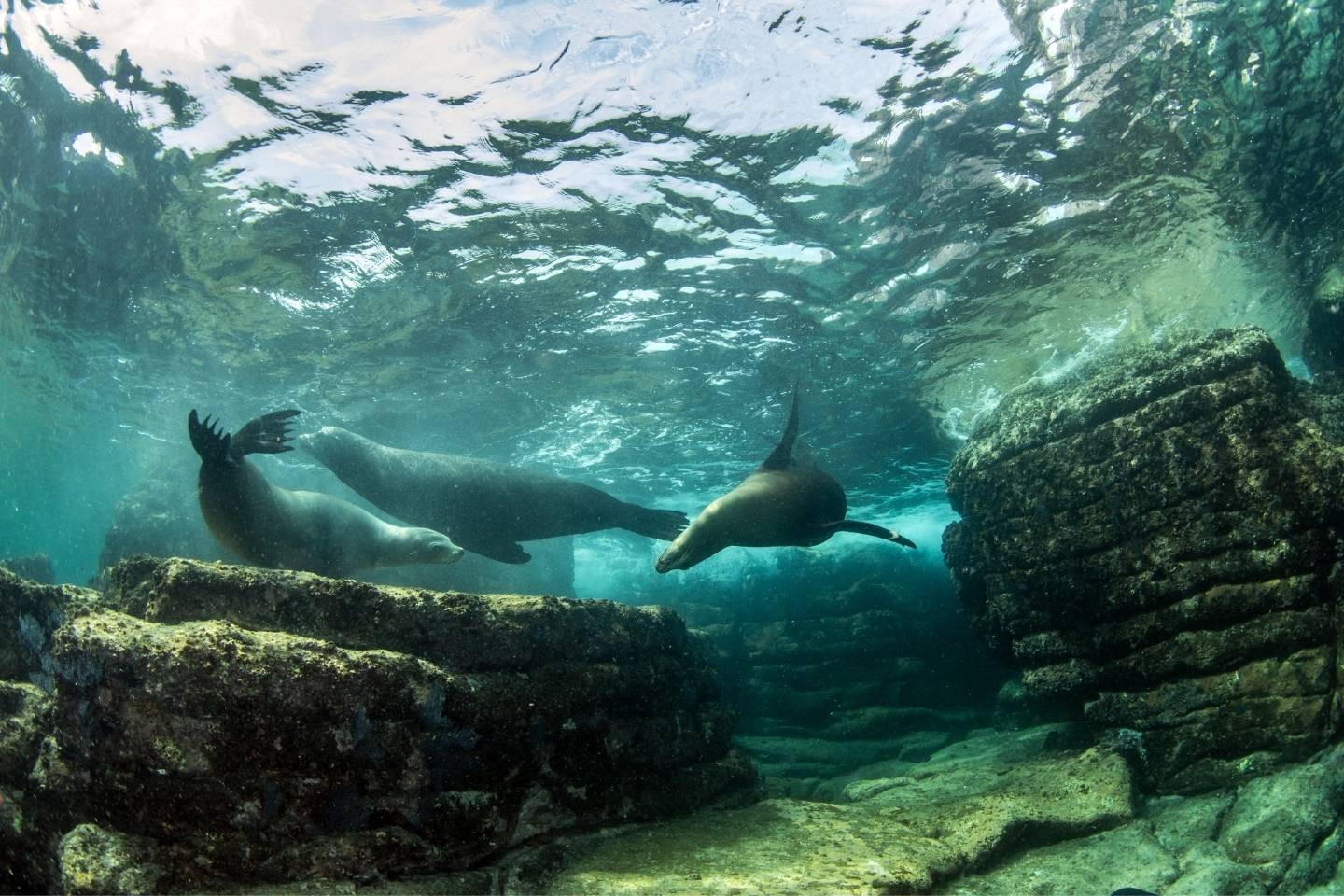
7. Socorro Island, Baja Peninsula
Have you ever wanted to do a liveaboard diving trip? Then this is the spot. Socorro Island is an epic diving destination in Mexico, but the only way to access it is through a liveaboard.
This is another pelagic diver’s paradise. Dive with wild dolphins, whale sharks, hammerheads, and some of the friendliest Manta Rays around. To put it frankly, the marine life here is insane!
Socorro Island is an epic dive destination. However, it is a seasonal spot and only accessible from November – May. This is mainly due to the weather. Advance divers are recommended as with large pelagics come currents.
It is located in the middle of the Pacific Ocean about 395 miles from Puerto Vallarta, which is why it can only be accessed by live about . However, it is an epic spot to have a unique secluded dive experience.
Editor’s Note: Considered Liveaboard Diving in Mexico? Check out these once in a lifetime trips!

8. Xcalak, MesoAmerican Reef
Back to the MesoAmerican Reef, but this time in a different location. To the southernmost point of Mexico. Since the reef is so large there are many different dive locations, each giving its own and unique experience.
The reef is a wildly diverse and connected ecosystem made up of not only protected coral reefs, but mangroves, rivers, and lagoons.
In Xcalack you have the unique opportunity to dive with manatees, as well as dolphins, manta rays, turtles, sharks, and more.
What makes this place special and unique is truly watching the manatees swim around you, they are so prevalent here that it is hard to have a dive without seeing one.
Also, it is home to massive tarpon fish. Large schools of massive tarpon fish swim all around you, making your dive feel prehistoric. If you are brave enough they even have dives where you can get up close and personal with a crocodile.
This is a place that is off the beaten path in Mexico, and not as popular with the tourists. So if you prefer to avoid crowds and see what Mexico is truly like, add this to your bucket list.
9. Guadalupe Island, Baja California Peninsula
Guadalupe Island offers a unique and rare experience that allows you to get up close and personal with great white sharks, which is all within the safety of a cage. Cage diving here is extremely popular, although quite expensive.
Australia and South Africa might be more well known for their great white shark encounters, but Guadalupe Island Liveaboards are actually a better spot to see them. This is mainly due to the fact that here you will find calmer waters, so if you get seasick like me you don’t have to worry.
You are almost guaranteed to see a great white during your dive as well. They have over 365 tagged and registered great whites, so your chances of seeing one are very likely. If cage diving is a dream of yours, definitely look into Guadalupe!
Guadalupe is a small and remote island located off Baja California, the only way to access it is by liveaboard. This not only keeps this dive site more reserved but also keeps the novice divers away. It is a great dive site for those divers who really appreciate sharks.
Update: 2021-2022 the shark diving in Guadalupe has been closed due to some unfortunate diving incidents that led to the injury / death of a great white shark. The Secretariat of Environment and Natural Resources in Mexico has placed a temporary pause on the expeditions here.
Update: On January 9, 2023, the Government of Mexico passed legislation banning all tourism, diving and fishing at Isla Guadalupe. Until the Mexican Government can be convinced to reverse its decision, shark diving at Isla Guadalupe is not possible.
Hopefully this will change soon with even more regulations to protect these magnificent creatures.
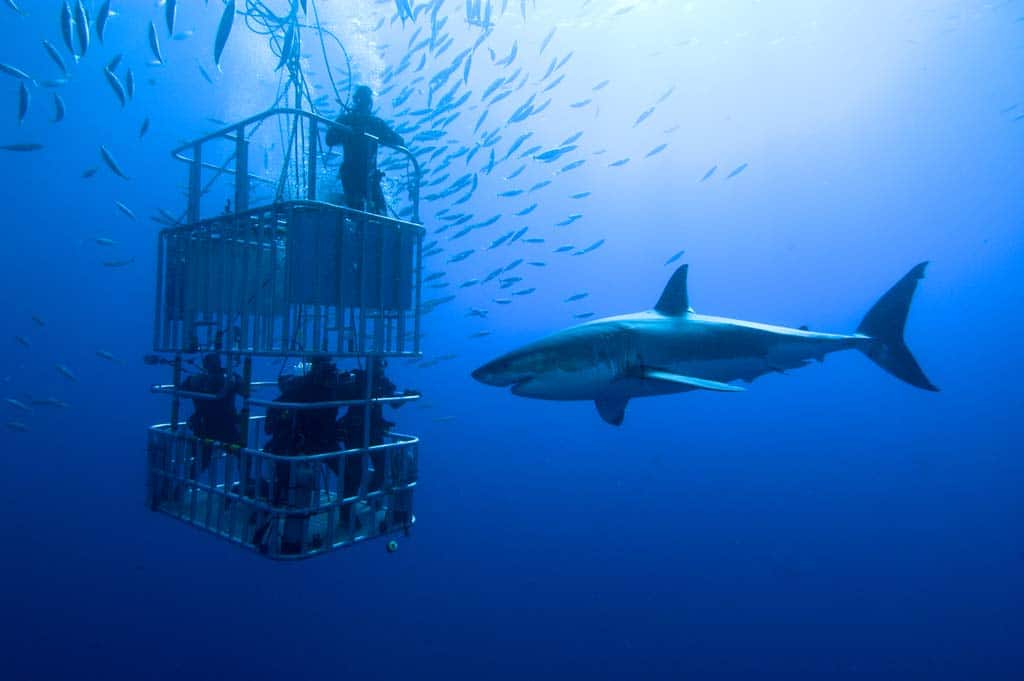
10. Cabo Pulmo, Baja California
Located on the southernmost part of Baja California sits Cabo Pulmo, an isolated and much forgotten dive location in Mexico. However, that doesn’t mean that it is any less special than any of the other spots previously mentioned.
Cabo Pulmo is a tiny remote village that draws divers in due to its protected coral reef located in the Pacific Ocean in Baja California. It is a prime example to see what we should be doing to protect our oceans. It was also named as a UNESCO World Heritage Site so the seas here are very well protected.
Cabo Pulmo is keeping the tourists out and putting its ecosystem first. It has continually refused big hotels from coming in here, as it doesn’t want the pollution they create.
There are a variety of dive sites within the national park which includes reefs, an underwater canyon, sand flats, and more. Expect to see giant manta rays, eagle rays, nurse sharks, bull sharks, and a wide plethora of marine life!
This is a great spot for those who want to scuba dive while wanting to escape the crowds, but not wanting to do a live aboard.
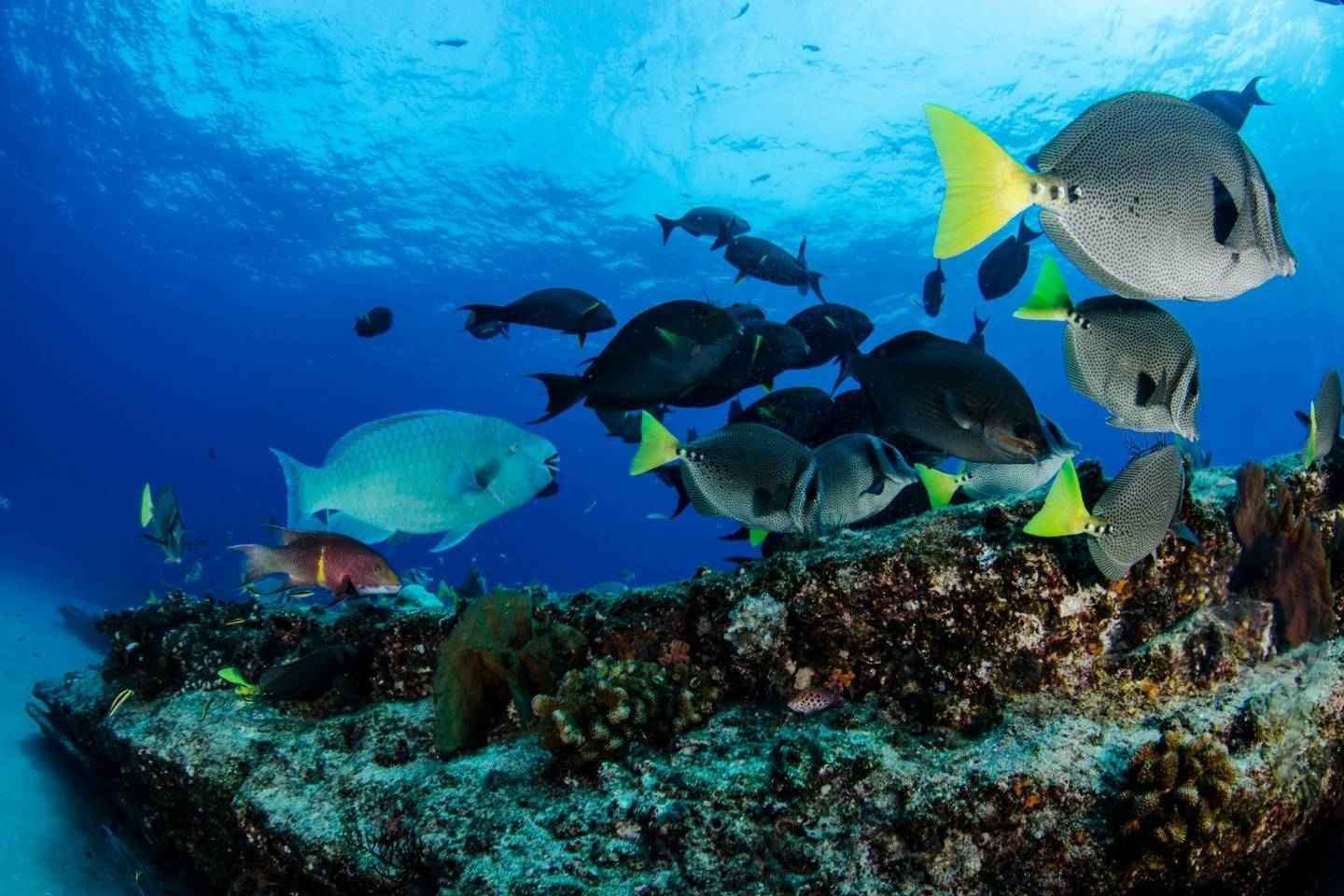
Liveaboard Diving in Mexico
Mexico is a popular destination for liveaboard diving, with a variety of options to choose from depending on your interests.
Two of the most popular destinations for liveaboard diving in Mexico are Socorro Island and Guadalupe Island.
Socorro Island is located about 250 miles off the coast of Baja California and is known for its clear waters and diverse marine life, including dolphins, whales, and sharks.
Guadalupe Island, located about 150 miles off the coast of Baja California, is known for its cage diving with great white sharks.
In addition to Socorro Island and Guadalupe Island, there are also numerous liveaboard options in Baja California, which is known for its large pelagic species such as whales. The best time to go liveaboard diving in Mexico depends on the specific destination and the species you hope to see.
For example, whale watching season in Baja California typically runs from December to April, shark diving on the other hand at Guadalupe Island is typically best from August to October.
To see a full list of the best liveaboards in Mexico, check out the links below.

What you need to know before Diving in Mexico
Mexico is a great spot to plan your next dive vacation. It is a vastly large country with many different and unique dive destinations that you can explore. Which is why myself and many other divers continue to return here.
Before planning a dive trip to Mexico be sure to do your research and plan ahead. Knowing what time of year it is and what dive sites will be better, can help you showing up expecting to see whale sharks when it is not whale shark season.
Check out this Mexico travel guide for awesome tips on where to stay and what to do!
Personally, I always like booking most of my dives ahead of time as well. This will help me ensure that I build a good relationship with the dive center before I arrive on my holiday.
They can help to ensure that I am booking the right dive sites and that I won’t forget to bring anything important for my trip. Not only that, but they are also a great resource for local information and tips.
Diving in Mexico is fun. It is a bucket list county that every diver needs to add to their list. Besides all the amazing dives sites you have to choose from, Mexico is a county that is full of mouthwatering food, epic people, and enriched culture.
Every trip to Mexico leaves me wanting to see more of this beautiful country. Trust me when I say, you will be happy you made the trip
Planning a Trip to Mexico? Read these Guides:
Inspired? Pin it!
